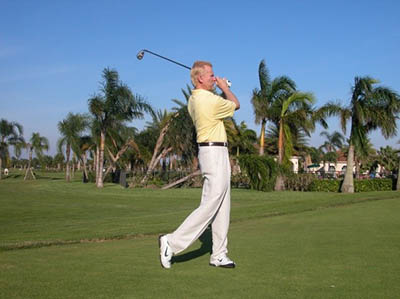Pre-Shot Routine Gives You Power

By Dr. T. J. Tomasi, Keiser University College of Golf Senior Faculty and Director of Research
The so-called shot routine is actually a ritual involving the exact repetition of a sequence — a repetition that creates an aura of control and power, even when things are going poorly. Here it is in its simplest form:
Position: Stand behind the ball and make your shot plan based on your strength and weakness profile. This congruence between your plan and your capabilities expresses itself as a “go signal” in your brain.
Relax: The relaxation response is a scientifically verified bodily process that, when implemented, allows you to take control of your stress level.
Image: Image the shot to cue motor behavior. Images are powerful tools used by champions in all occupations.
Rehearsal: The practice swing is a kinesthetic cue that can serve as a perfect rehearsal for your actual swing.
Aim then Align: When you reach the ball, first aim your clubface where you want the ball to start, and then align your body where you want your clubface to swing.
Physical swing: Guided by imagery, the swing itself is a freewheeling physical act sans manipulation that relies on the principles of physics. While there is much motion, the swing is quiet. Energy is exploding naturally with levers under the control of timing driving their force to the ball. But the motion is a thing on its own — the “ding an sich” (thing per se), as the philosopher, Immanuel Kant might have said, if he had been a golfer.
Post-Swing Marking
If the shot is good, you send it to memory via a mark (a pre-arranged tag such as a fist pump or a keyword like ‘perfect’- a physical gesture that represents an emotional state). If it’s not a good shot, then replay it with a practice swing – you re-image the shot – then mark it. This marking procedure allows you to record a good result for each shot. Playing golf using imagery is a key aspect of your ritual. Think how strong your game would be if you never saved a bad shot in memory. All golfers hit bad shots, but only the bad golfers save them.
Note: Bad shots are not ignored, for they form the basis for your practice attention. Bad shots must be treated as information rather than stored by emotionalizing. Failure is fertilizer to grow a new you.
Takeaway: Most golfers miss out on the power of the shot ritual. It seems so trivial compared to the actual physical swing that the tendency is to skip it. This is a mistake because your brain triages your memories using emotions. Many golfers never figure out how to control this process, yet it is the gateway to playing your best golf. Bad shots are objectified as information, while good shots are immortalized by emotionalizing. The process is simple but not trivial.

The target picture is strong and compelling as an image. I’m not swinging at the ball; I’m swinging at the target.

The evaluation and marking process now begins – if it’s a good shot – mark it and if it’s not, replay it in your mind with a practice swing – see the result you intended, then mark it. If your ritual is strong enough, you will never mentally save the results of a bad shot.
If you’d like to study with Dr. Tomasi and other PGA Master Professionals, contact The College of Golf today.














